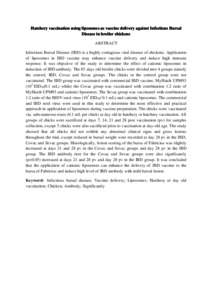Citation
Wahab, Mukminah Sakinah and Bejo, Mohd Hair and Omar, Abdul Rahman and Ideris, Aini
(2017)
Hatchery vaccination using liposomes as vaccine delivery against Infectious Bursal Disease in broiler chickens.
Journal of Animal and Veterinary Advances, 16 (8).
122 - 128.
ISSN 1680-5593; ESSN: 1993-601X
Abstract
Infectious Bursal Disease (IBD) is a highly contagious viral disease of chickens. Application of liposomes in IBD vaccine may enhance vaccine delivery and induce high immune response. It was objective of the study to determine the effect of cationic liposomes in induction of IBD antibody. The 85 days old broiler chicks were divided into 4 groups namely the control, IBD, Covac and Sevac groups. The chicks in the control group were not vaccinated. The IBD group was vaccinated with commercial IBD vaccine, MyHatch UPM93 (103 EID50/0.1 mL) whilst the Covac group was vaccinated with combination 1:2 ratio of MyHatch UPM93 and cationic liposomes. The Sevac group was vaccinated with combination 1:2 ratio of the IBDV seed virus (103 EID50/ 0.1 mL) and cationic liposomes. The commercial and IBD seed virus were used in this study to determine the most effective and practical approach in application of liposomes during vaccine preparation. The chicks were vaccinated via. subcutaneous route (0.1 mL per chick) at day old in hatchery or hatchery vaccination. All groups of chicks were sacrificed at days 7, 14, 21 and 28 post vaccination (pv) for samples collection, except 5 chicks were also sacrificed prior to vaccination at day-old age. The study showed that all chicks did not exhibit any abnormal clinical signs and gross lesions throughout the trial, except reduced in bursal weight were recorded at day 28 pv in the IBD, Covac and Sevac groups. Histologically, lesion scoring of the bursa of Fabricius was slightly increased at days 21 and 28 pv in the Covac and Sevac groups and day 28 pv in the IBD group. The IBD antibody titre for the Covac and Sevac groups were also significantly (p<0.05) increased at days 21 and 28 pv and day 28 pv in the IBD group. It was concluded that the application of cationic liposomes can enhance the delivery of IBD vaccine to the bursa of Fabricius and induce high level of IBD antibody with mild bursal lesion.
Download File
![[img]](http://psasir.upm.edu.my/62007/1.hassmallThumbnailVersion/Hatchery%20vaccination%20using%20liposomes%20as%20vaccine%20delivery%20against%20Infectious%20Bursal%20Disease%20in%20broiler%20chickens.pdf)  Preview |
|
Text
Hatchery vaccination using liposomes as vaccine delivery against Infectious Bursal Disease in broiler chickens.pdf
Download (6kB)
| Preview
|
|
Additional Metadata
Actions (login required)
 |
View Item |

